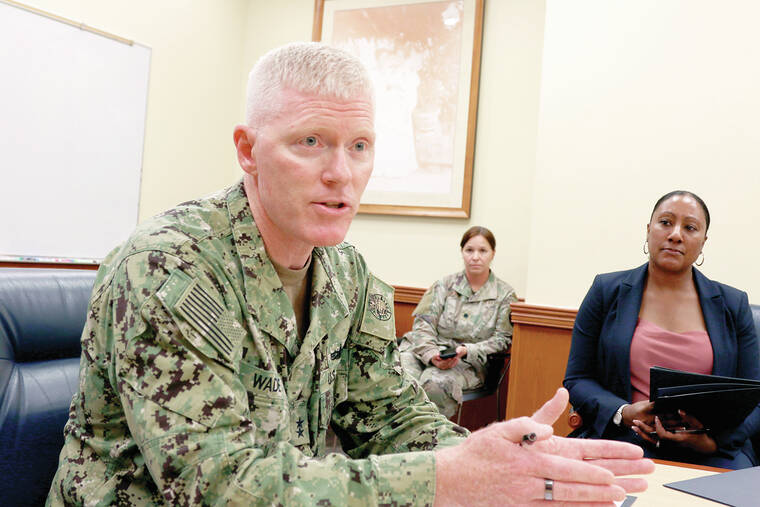Navy admiral to seek community input on Red Hill fuel tanks
JOINT BASE PEARL HARBOR-HICKAM, Hawaii — The commander of the task force responsible for draining fuel from a World War II-era storage tank facility that leaked jet fuel and poisoned Pearl Harbor’s tap water last year said Monday he’s exploring ways to get community feedback.
Rear Adm. John Wade told reporters at a news conference he may establish an advisory group, but he’s not sure yet what form it will take.
He said getting input from the community will help him be more responsive. He said Hawaii’s elected officials told military leaders that it would be valuable for them to give the community a voice in their work.
“I don’t have the structure yet. It’s still a work in progress, but I think it’s something that’s important,” said Wade, the commander of Joint Task Force Red Hill.
Defense Secretary Lloyd Austin announced Wade’s appointment last month.
In November, jet fuel spilled from a drain line at the Red Hill Bulk Fuel Storage Facility, flowed into a drinking water well and then into the Navy’s water system serving 93,000 people in and around Joint Base Pearl Harbor-Hickam. Nearly 6,000 sought medical attention for ailments like nausea, headaches and sores. The military put about 4,000 families in hotels for several months.
The military plans to remove more than 100 million gallons (378.54 million liters) of fuel from the 80-year-old tanks by July 2024, and then close the facility afterward.
Wade said he’s started reaching out to Hawaii’s congressional delegation and other local leaders — including Ernie Lau, the chief engineer of the Honolulu Board of Water Supply and one of the strongest critics of how the Navy has managed Red Hill over the past decade.
Kathleen Pahinui, a spokeswoman for the Board of Water Supply, said Lau had a short introductory conference call with Wade on Friday and they expect to host Wade for an in-person meeting soon. She said the call went well and they look forwarding to meeting him and his team in person.
In addition to Lau, Wade said he also met with Hawaii Department of Health Director Dr. Libby Chair and her environmental deputy, Kathleen Ho.
Wade was already assigned to Hawaii last year when the spill occurred, as the person in charge of operations and training at U.S. Indo-Pacific Command. He said he wasn’t among those that had to move out their homes, but he — like others — questioned the safety of his water.
Some military families have complained of continuing health problems like seizures and gastrointestinal issues and filed a lawsuit against the federal government in August.
As head of the task force, Wade will report to Austin through Adm. John. C. Aquilino, the Indo-Pacific Command commander.
Indo-Pacific Command said in a news release last month that this “will ensure awareness and support at the highest levels of the Department and as well as provide accurate and timely information to the local community.”
Austin met with Wade last week during a visit to Hawaii that also included meetings with his counterparts from the Philippines, Australia and Japan. Austin didn’t talk to local media afterward.

